A unique garden design is a common goal. We all ask the same questions and then go our own ways with the answers. Here are the questions I hear most often, with no-frill answers that you can personalize.
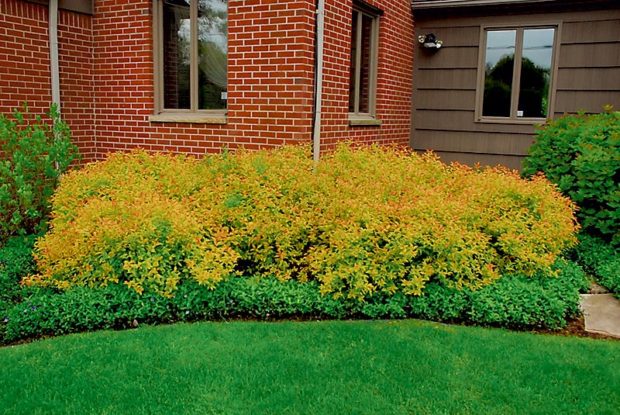
What can I plant for the most color and lowest maintenance?
Plant what will thrive in that spot. Avoid what will merely survive. Say no to what will only “tolerate” those conditions. Only when it thrives can a plant be all it can be and take care of itself.
Make the most of experts by taking a list of your site specifics (see the sidebar “Matching plant and site”) to your local garden center and asking for plant possibilities. Then sit down with books or at your computer, search for images and descriptions of those plants, and decide which you will like best. And, where possible, make sure to purchase the plants from the experts who helped you.
Choose only a few, because less is more when it comes to visual impact and low maintenance. Focus on the shrubs and low groundcovers, since plantings heavy on those two elements are the simplest to maintain. Do not make your choices based on flower color but on foliage—flowers last only weeks but gold, gray, maroon, white-edged, or blue-green leaves are there all season, even all year. After foliage, go for naturally crisp plant shapes and non-floral color such as bark or berries.
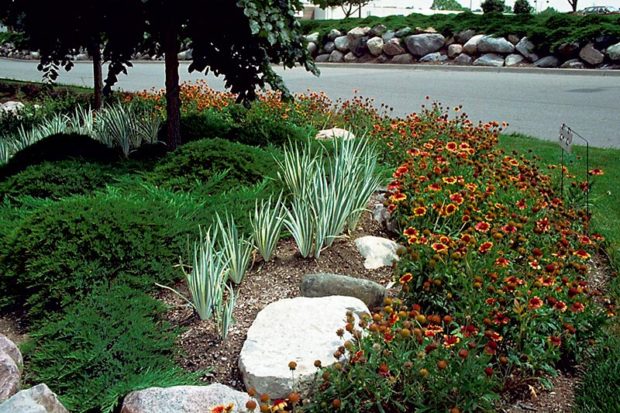
Matching plant and site
To make a great match, fill in the blanks or circle the appropriate terms to describe your site. Choose or keep only those plants that fit every category.
Sun: A plant there will cast a crisp shadow for ____ hours each day. More than 6 hours = full sun. Less than 4 = shade.
Soil: The soil is _________ (terms from below that apply)
- Sticky (clay)
- Gritty (sand)
- Dark (rich)
- Pale (lean)
- Well-drained (18-inch deep hole filled with water empties within 24 hours)
- Moist, even days after a rain
- Dries out quickly
- Loose, airy
Irrigation: Is _________ (terms from below that apply)
- Readily available/automatic system
- By hand the first year, then rain-only
Exposure: ____ (yes/no) the plant may have a greater than average chance of having to deal with frost, strong wind, exhaust gases, pool splash, pet/child contact or destructive animal(s) including _________.
Resources that list plants by site or provide detailed site info:
- Landscape Plants for Eastern North America, Harrison Flint
- Native Trees, Shrubs & Vines for Urban & Rural America, Gary Hightshoe
- Manual of Woody Landscape Plants, Michael Dirr
- Perennials and Their Garden Habitats, Richard Hansen & Friedrich Stahl
- Perennial Reference Guide, Karleen Shafer & Nicole Lloyd
What are some fast-growing trees? We need shade!
Take care in what you ask for. There are good, fast trees (see the sidebar “Shade trees that grow quickly”) but even the best tend to be very large when fully grown, have weaker wood, and host more insects than trees that grow more slowly. Shading a table with an umbrella or covering a sitting area with a pergola or pavilion can give you shade while you wait for a slower species.
If you do plant for speed, give the tree lots of room. Think twice about using such a plant to shade areas where twig shedding and insect fall-out would reduce the tree’s worth. Where space is limited, planned obsolescence is a good strategy—plant one fast tree with a slower tree nearby, letting the speedy one serve for just 10 or 15 years while the other bulks up.
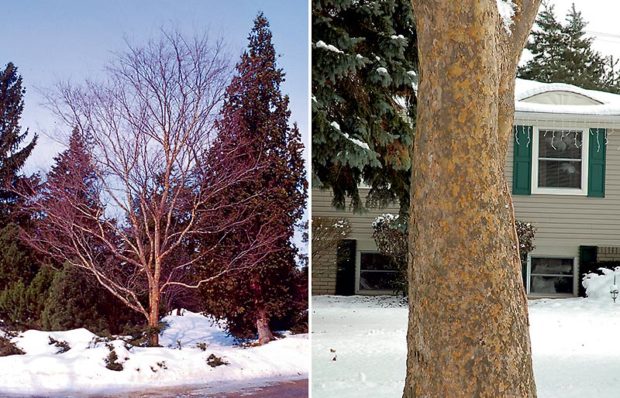
Shade trees that grow quickly
- Catalpa
- Ginkgo (fast in youth) – Fruitless/male varieties such as ‘Autumn Gold’
- Katsura (Cercidiphyllum japonicum)
- Lacebark elm (Ulmus parvifolia)
- Poplar (Populus hybrids) – Male, disease-resistant cultivars such as ‘Eugenei’ and ‘Assiniboine’
- Red-silver maple hybrids (Acer x freemanii) such as ‘Autumn Blaze’
- River birch (Betula nigra)
- Thornless honeylocust (Gleditsia triacanthos var. inermis)
How can I make my doorway look (better, more inviting, classier, more colorful, etc.)?
Spaciousness is what’s inviting, refreshing, most complementary of architecture around an entry, enduring—and most often missing in modern landscapes. So plan for equal amounts space and plants at an entry. Give every plant or group of like plants room so that even at maturity it will not touch its neighbors. You can “color” the space between plants with mulch or a very low groundcover.
Choose only what will thrive on the site and strive for calm combinations. A pleasing trio is plenty (see the sidebar “Making great combinations in the landscape”). To place a combination, look at your door as if you are a guest just pulling into the driveway or starting up the walk. Fill that person’s whole view with just one group of plants. If the walkway is long with nooks that are only revealed as a person walks toward the door, or your yard is large enough that you can turn your head to see another view that does not include the door, plant a second combination.
Within the landscape, repeat or give a nod to something in the architecture of the entry. For instance, if the door is painted an accent color, echo that in foliage or pottery. If there is a distinctive shape in windowpane, gable or trim, carry that out into a bench, trellis or sculpted plant.

Making great combinations in the landscape
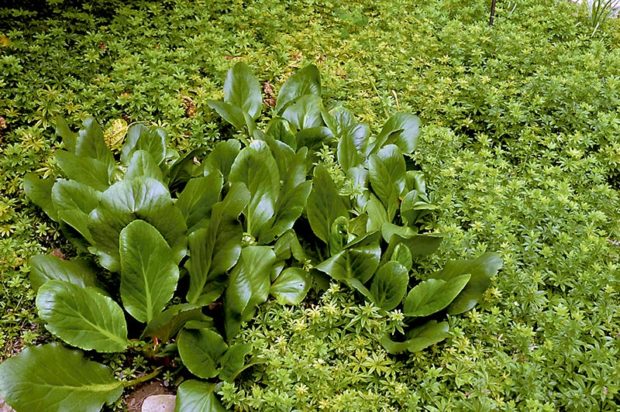
Combine for natural shape, foliage color and texture. For example, fine-textured carpet juniper ‘Mother Lode,’ fine-mounded barberry, and coarse-textured, vase-shaped smoke bush. For more subtlety, downplay the contrast between elements—make it a ‘Gold Nugget’ barberry with ‘Mother Lode’ juniper and the green-leaf American smoke tree. For more drama, increase the contrast by using ‘Crimson Pygmy’ barberry or purple-leaf smoke tree.
Evaluate the seasons of special interest provided by a combination and begin additional groups with an eye toward filling seasonal gaps. The juniper-barberry-smoke tree combination provides winter interest, particularly vivid spring foliage effects, and July bloom. So a second group might include a June-blooming tree lilac, ornamental grass that turns red in fall and an attractive, winter-hardy planter that can showcase a summer-blooming annual.
What can I plant that grows quick, for privacy?
Fences grow faster than hedges. Where traditional fencing is not allowed or doesn’t fit the overall picture, use individual sections of fencing or near-solid trellis, strategically placing them between the viewer in your landscape and intrusive elements outside your yard.
Stick with classic hedge material for screening. Those in that category are dense, look good even if sheared, and are dependable across a variety of growing conditions so that they maintain a uniform appearance even when stretched across a property. Privet, boxwood, yew, spirea, burning bush, arrowwood viburnum, barberry, hornbeam, and arborvitae are classics.
Do not crowd a hedge as you plant. Leave room between plants so that roots and new branches can develop in those spaces, or you will probably experience mid-hedge plant losses, uneven growth, and pest problems throughout the life of the hedge.
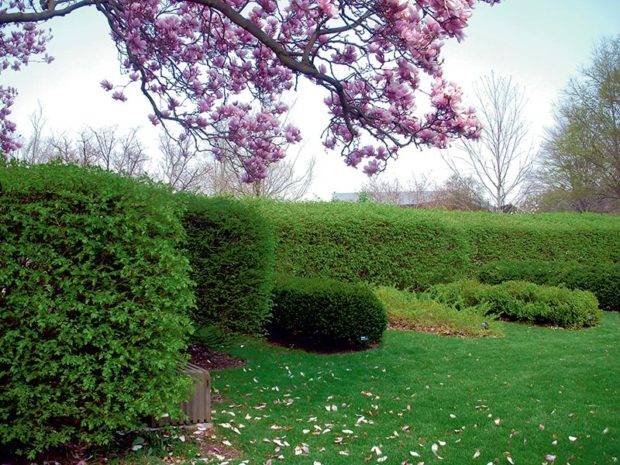
What can I plant to soften the corner of the house?
Be clear in your definition of “soften” when you ask a designer this question. If you mean to interrupt lines that seem too straight or unnatural when seen as part of a landscape, choose a plant with a naturally rounded or irregular form and place it where just part of that plant will overlap a segment of the offending line. Don’t crowd the building and don’t repeat or cover the entire line.
So if it is the vertical line of the house wall you wish to soften, you might position a small, round-topped crabapple such as Sargent, so that one side of its mature canopy will cover part of the wall’s edge. Place the tree so that a person in your primary viewing location will see the trunk as well away from the house—not lined up with that vertical wall edge. If the horizontal line where your house meets the ground is the part of the corner you want to moderate, plant a low, coarse groundcover such as perennial forget-me-not (Brunnera macrophylla) along one portion of that line but do not repeat the entire line with the groundcover.
Sometimes when a person says they wish to soften a corner, they mean to lead the eye less abruptly from an overly large house to the ground. That usually requires a horizontal space apparently as wide as the house wall is tall. This can be accomplished with a deep, wide bed extending from the house out into the yard, or with an island in the lawn. In either space, use plants of graduated size to create a skyline beginning at the height of the eaves and descending to the ground.
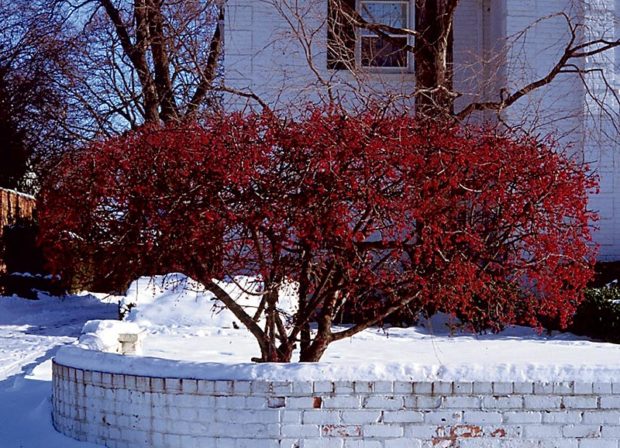
What should I plant in the space between the house and the front walk?
Usually, less is best in these spaces which were created by builders, not gardeners. Fill such a space with a mass of low groundcover or with long-interest perennials (see the sidebar “Long-interest, front-walk perennials”). Avoid filling it with shrubs, most of which will outgrow that space unless continually pruned—that means more work and less natural beauty.
If the area is large, punctuate the groundcover with something like a sculpture, a neat clump-forming perennial, a group of boulders, a sinuous and rocky dry stream bed, a lamp, or birdbath. Place the interruption(s) with care so they fit the feel of the overall landscape. A center placement or a line of equally-spaced, matching items works in a formal setting. One off-center item or three similar but unequal items placed to describe an unequal triangle will work better where informality and asymmetry are the rule.
Avoid confusing plantings in this area with “something for the front of that wall.” Do this by keeping your main viewer’s location in mind—if you are in the street, on the public walk, or looking in from the foot of the driveway, anything between you and the house will appear to be in front of the house. Plantings outside the front walk or in the lawn can fill that visual space more gracefully and without the increased work required to maintain plants in small spaces.
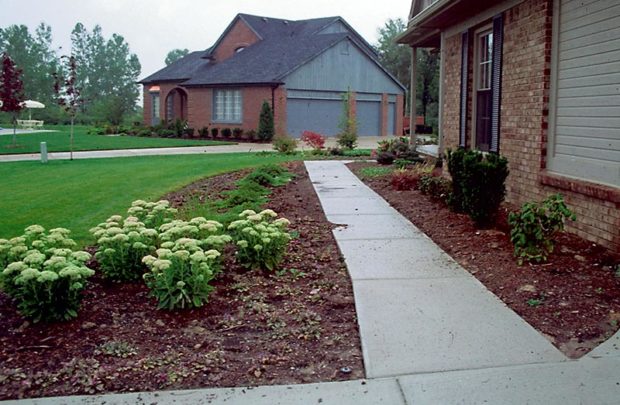
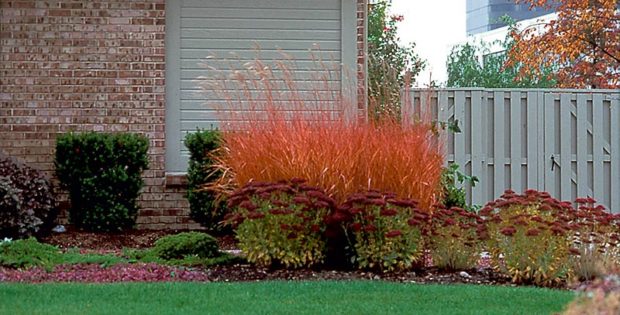
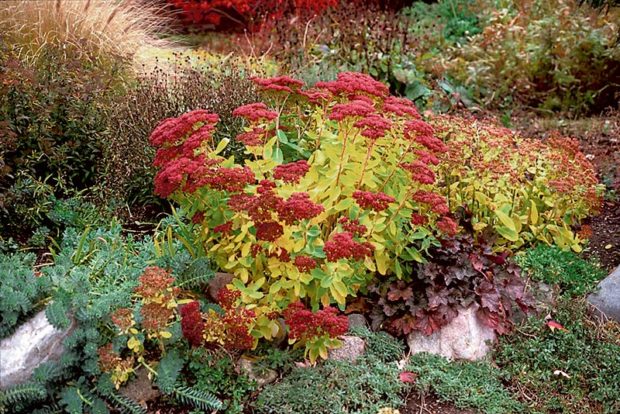
Long-interest, front-walk perennials
For high-profile places, mass perennials that look neat when not in bloom, have an attractive winter presence, and require minimal care. Examples:
- Bigroot perennial geranium (G. macrorrhizum)
- Blue oat grass (Helictotrichon sempervirens)
- Coral bells and foamy bells (Heuchera and Heucherella varieties)
- Lenten rose (Helleborus x orientalis)
- Tall stonecrop (Sedum including ‘Autumn Joy’)
How can I hide the (utility box, air conditioning unit, trash cans, well head, etc.)?
Distract the viewer by providing something nice to look at along a different line, then incorporate the unfortunate element within plants or features that frame the more desirable feature. For instance, where a utility box begs attention, you might place a substantial birdbath or decorative scarecrow in the foreground to the left or right of the utility box, then plant a mass of low, dense shrubbery such as dwarf spirea or deutzia to embrace or surround your chosen whimsy. Let that frame swallow the utility box or cross between it and the viewer, obscuring it.
Alternatively, embrace and multiply the ugly feature. Where there is a wellhead that catches your eye, plan to cover it with a fiberglass boulder, but put that rock in a bed that has several clusters of equally or more impressive native stone. Be careful to avoid drawing the bed to center on the wellhead.
As another example of hiding something in plain view: If a square of concrete marks a septic tank cover and irritates your aesthetic sensibilities, give that concrete a crowd to blend into. Add flagstone or concrete stepping stones in a pleasing pattern across the lawn.
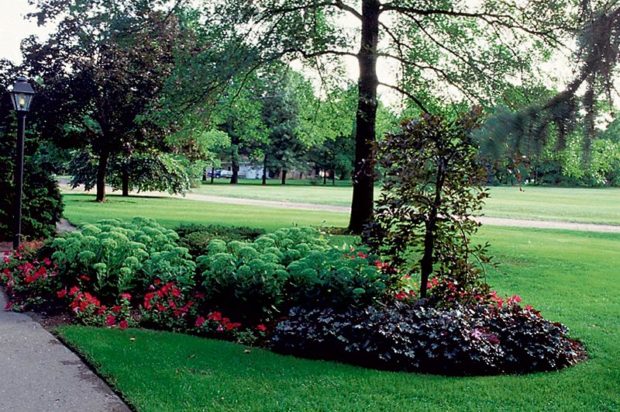
What can I plant along the edge of the deck/patio?
Gardens are least expensive and simplest to tend when they are close at hand, so if you want a flower garden, put it here. However, don’t plant it right along the edge of a deck or patio if you cannot see that area from your lounge chair. Narrow borders hidden from everyday view along the foot of a raised deck or patio should be filled with groundcover or simply mulched to reduce weeding and edging chores, and a separate garden placed far enough from the edge to be easily seen and enjoyed.
Use tall features carefully around a sitting area since large, dense objects can block breezes and light, creating an oppressive or claustrophobic atmosphere. Position shrubs or a trellis to block unsightly views but do not mass them or use species so massive that they must be kept sheared.
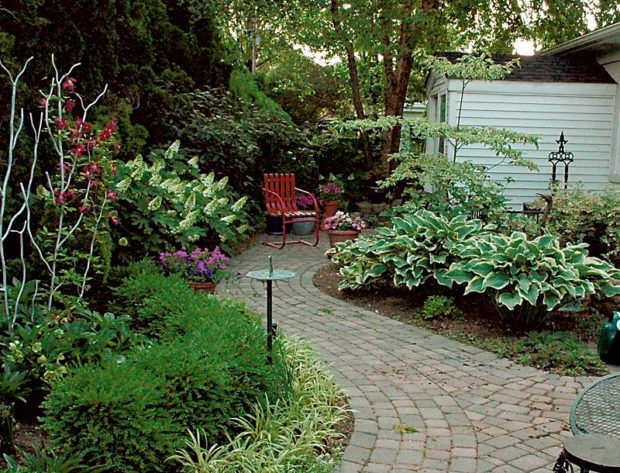
Where can I get the cheapest plants?
Cheap plants are not what you need! Look for the right plants in an affordable size at a garden center that produces healthy plants. Make a list of the plants you’ve decided to use—include the scientific name and variety—and take that to a local garden center.
Small, healthy plants grow more quickly than anyone expects. If you planned combinations for pleasing contrast and then tighten the spacing between plants of the same kind to leave a bit more space between groups than between plants of one kind, even small plants have immediate, pleasing impact.
Don’t rush as you landscape. It’s a long-term investment, so take one question and develop one lasting solution at a time.
Article by Janet Macunovich and photos by Steven Nikkila, www.gardenatoz.com.

Leave a Reply